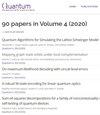Trainability and Expressivity of Hamming-Weight Preserving Quantum Circuits for Machine Learning
IF 5.1
2区 物理与天体物理
Q1 PHYSICS, MULTIDISCIPLINARY
引用次数: 0
Abstract
Quantum machine learning (QML) has become a promising area for real world applications of quantum computers, but near-term methods and their scalability are still important research topics. In this context, we analyze the trainability and controllability of specific Hamming weight preserving variational quantum circuits (VQCs). These circuits use qubit gates that preserve subspaces of the Hilbert space, spanned by basis states with fixed Hamming weight $k$. In this work, we first design and prove the feasibility of new heuristic data loaders, performing quantum amplitude encoding of $\binom{n}{k}$-dimensional vectors by training an $n$-qubit quantum circuit. These data loaders are obtained using controllability arguments, by checking the Quantum Fisher Information Matrix (QFIM)'s rank. Second, we provide a theoretical justification for the fact that the rank of the QFIM of any VQC state is almost-everywhere constant, which is of separate interest. Lastly, we analyze the trainability of Hamming weight preserving circuits, and show that the variance of the $l_2$ cost function gradient is bounded according to the dimension $\binom{n}{k}$ of the subspace. This proves conditions of existence/lack of Barren Plateaus for these circuits, and highlights a setting where a recent conjecture on the link between controllability and trainability of variational quantum circuits does not apply.用于机器学习的哈明-保权量子电路的可训练性和表达性
量子机器学习(QML)已经成为量子计算机在现实世界中应用的一个有前途的领域,但近期的方法及其可扩展性仍然是重要的研究课题。在此背景下,我们分析了特定汉明保权变分量子电路(vqc)的可训练性和可控性。这些电路使用量子比特门来保存希尔伯特空间的子空间,这些子空间由固定汉明权值k的基态所跨越。在这项工作中,我们首先设计并证明了新的启发式数据加载器的可行性,通过训练一个$n$量子位量子电路对$\binom{n}{k}$-维向量进行量子幅度编码。通过检查量子费雪信息矩阵(QFIM)的秩,使用可控性参数获得这些数据加载器。其次,我们为任何VQC状态的QFIM的秩几乎在任何地方都是恒定的这一事实提供了理论证明,这是单独感兴趣的。最后,我们分析了Hamming保权电路的可训练性,并证明了$l_2$代价函数梯度的方差根据子空间的维数$\binom{n}{k}$有界。这证明了这些电路存在/缺乏贫瘠高原的条件,并突出了最近关于变分量子电路的可控性和可训练性之间联系的猜想不适用的设置。
本文章由计算机程序翻译,如有差异,请以英文原文为准。
求助全文
约1分钟内获得全文
求助全文
来源期刊

Quantum
Physics and Astronomy-Physics and Astronomy (miscellaneous)
CiteScore
9.20
自引率
10.90%
发文量
241
审稿时长
16 weeks
期刊介绍:
Quantum is an open-access peer-reviewed journal for quantum science and related fields. Quantum is non-profit and community-run: an effort by researchers and for researchers to make science more open and publishing more transparent and efficient.
 求助内容:
求助内容: 应助结果提醒方式:
应助结果提醒方式:


